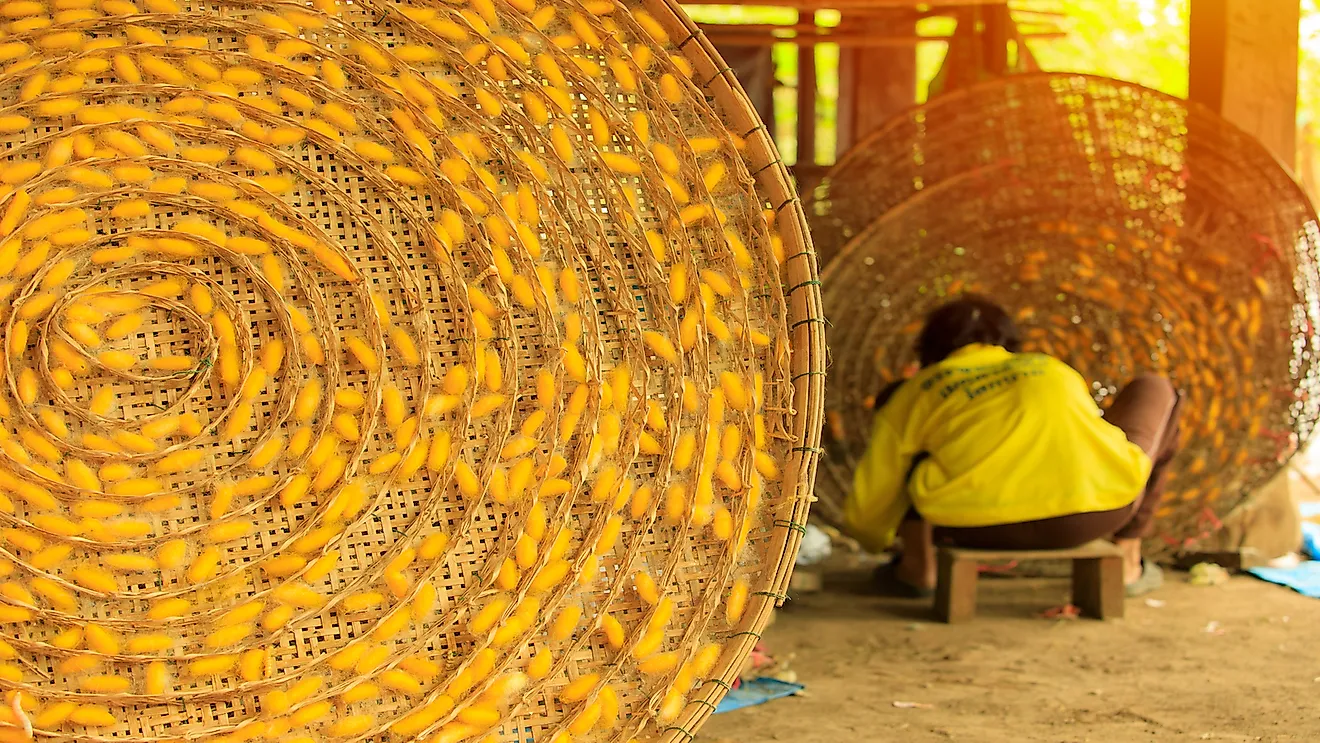How Is Silk Produced From Silkworms?

The importance of silk in the cloth-making industry cannot be exaggerated. Textiles made of silk fiber are common throughout the world, especially in China where silk production was started. Clothes made from silk are particularly popular because of their texture. Such material has a shimmering appearance and is able to refract the light from different angles, thus producing different colors. Silk fiber can be obtained from several insects but the most popular one is silkmoth. Important to note is that the fiber is only produced by the larvae of the insect. Silk can also be obtained from other insects such as wasps, bees, ants, beetle, flies, and fleas.
Brief History Of Silk Production
According to historians, silk production originated in China during the Neolithic period of the Stone Age. Production of silk was confined to the region of China until the opening of Silk Road in the late half of the first millennium BC. However, even with the opening of the trade route, China still maintained a monopoly over the production of silk for thousands of years. Silk was not only used for making clothes but also used for several other applications such as writing. From around 300 AD, the cultivation of silk reached Japan and by 552 AD, the Byzantines had managed to cultivate silkworm eggs and were able to begin its cultivation. Around the same time, the Arabs began manufacturing silk. The spread of sericulture rendered Chinese silk export less important although they still dominated the luxury silk market. Silk found its way into Western Europe via the Crusades. From the Italian states, silk was exported to the rest of Europe. Europe’s silk industry was completely transformed during the Industrial Revolution. New weaving techniques improved the efficiency of production. However, it was during this period that the silk industry faced stiff competition from the cotton industry.
About The Silkworm
Domestic silkmoth, scientifically referred to as Bombyx mori, is a moth belonging to the family Bombycidae. It is an economically important insect and the chief producer of silk. Silk is mainly produced by silkworm which is the larva of the silkmoth. Silkworms mainly feed on mulberry leaves as well as other mulberry species. There are four main species of silkworms, namely Mulberry silkworm, Muga silkworm, Tasar silkworm, and Eri silkworm. The mulberry silkworm is divided into three groups; univoltine (mainly found in greater Europe) and bivoltine (found in China, Korea, and Japan). The univoltine type generates silk only once a year while the bivoltine type generates it twice a year. The third type is polyvoltine which is only found in the tropics and can have up to 8 separate lifecycles in a year.
Process Of Producing Silk
The process of silk production is known as sericulture. This process is divided into several stages but typically starts from cultivating silkworms on mulberry leaves. The female silkworm lays 300-400 eggs and insulates them on the leaves of the mulberry tree. In about 10-14 days each of the eggs hatches and produces a larva which is also known as a caterpillar. The larvae are covered in tiny dark hair. The larva begins molting when the head turns darker and may molt about four times after which the body turns slightly yellow and skin becomes tighter. As the larva prepares to enter the pupal stage, it encloses itself in a cocoon which is made of raw silk produced by the salivary gland. The final molt from larva to pupa takes place in the cocoon.
Harvesting of silk begins at the stage when the worm starts pupating in their cocoons. If the worm is left to survive after spinning its cocoon, the enzymes produced may be destructive to the silk and may cause the fiber to break down. To ensure that quality fiber is produced, the silkworm cocoons are dissolved in boiling water. The worms are killed by the heat and the hot water enables the extraction of long fibers. For 1 kg of silk to be produced, 3,000 silkworms must feed on 104 kg of mulberry leaves. The cocoon is made of raw silk thread of about 1,000-3,000 feet long and 0.0004 inches in diameter. It requires about 3,000 cocoons to produce one pound of silk.
Because the process of extracting silk from the cocoon involves the killing of the larva, sericulture has attracted criticism from animal rights activists. It is for this reason that the majority of the activists promote cotton spinning. Mahatma Gandhi is known for among other things criticizing silk production based on Ahimsa's philosophy of “not hurting any living thing.”
Silkworm Domestication And Breeding
Unlike the wild silkworm, the domestic silkworm has an increased cocoon size, higher growth rate, and an efficient digestion system. It has also adapted to living around humans and in crowded conditions. A domesticated male silkworm cannot fly and needs assistance to find a mate. Since its first domestication about 5,000 years ago in China, the production capacity has increased nearly tenfold. The principle of genetic breeding has been applied to silkworms for maximum output and is now only second to maize in exploiting the principle of crossbreeding and heterosis.
The aim of silkworm breeding is to improve output and maximize income. The main area of focus is improving the egg-laying capacity, disease resistance, health of the larva, and quality of the cocoon. It is a common understanding that a healthy larva leads to a healthy cocoon. However, the health of larva is dependent on pupation rate, shorter larval duration, and few dead larvae during molting. The healthy larva has a high pupation rate and cocoon weight.











